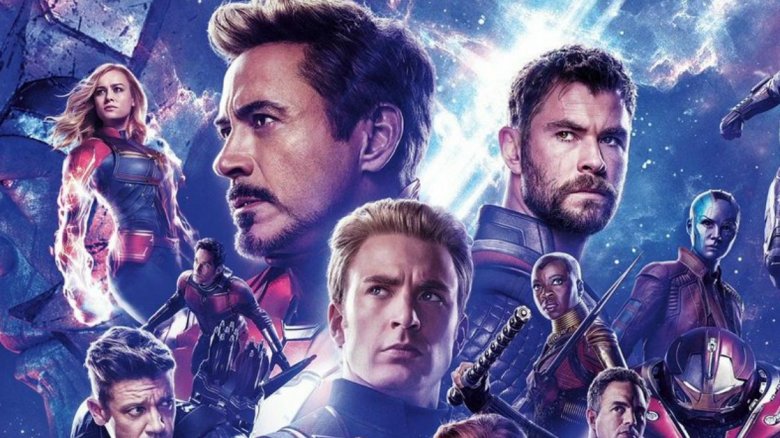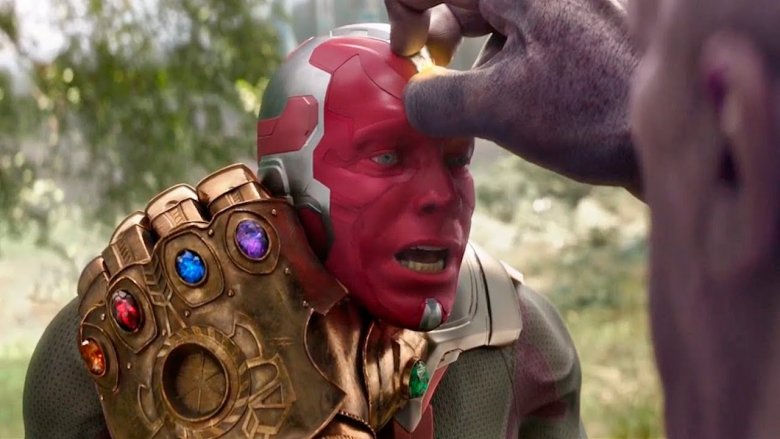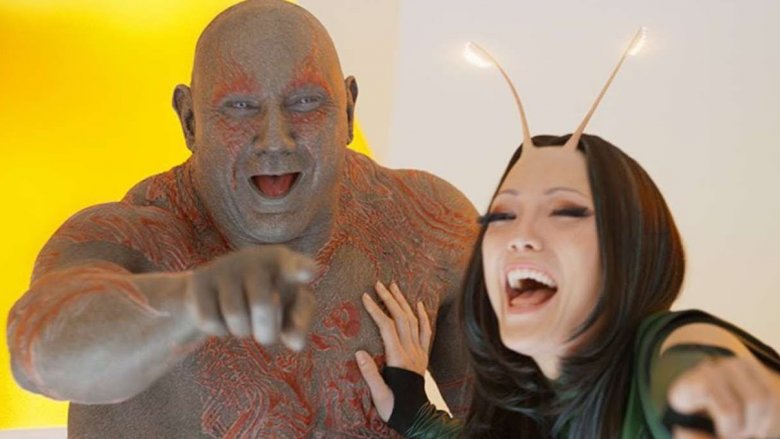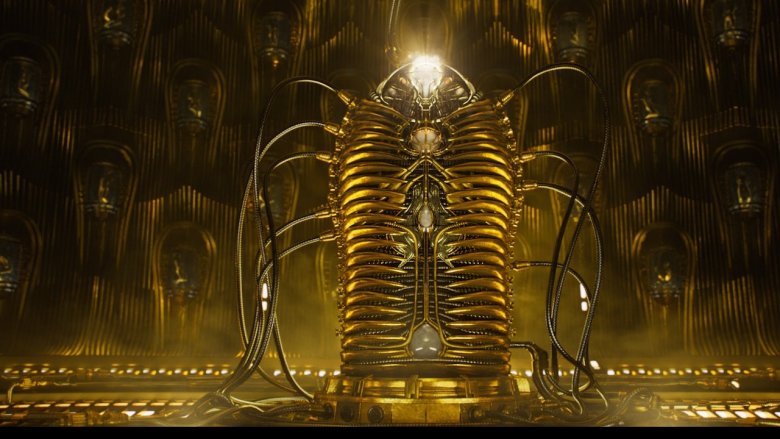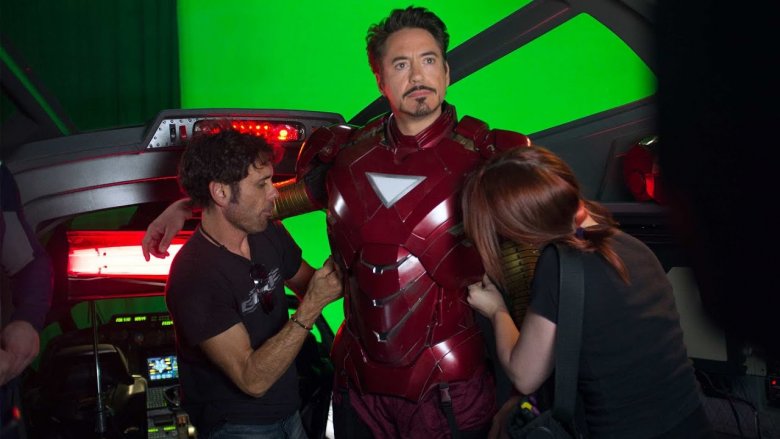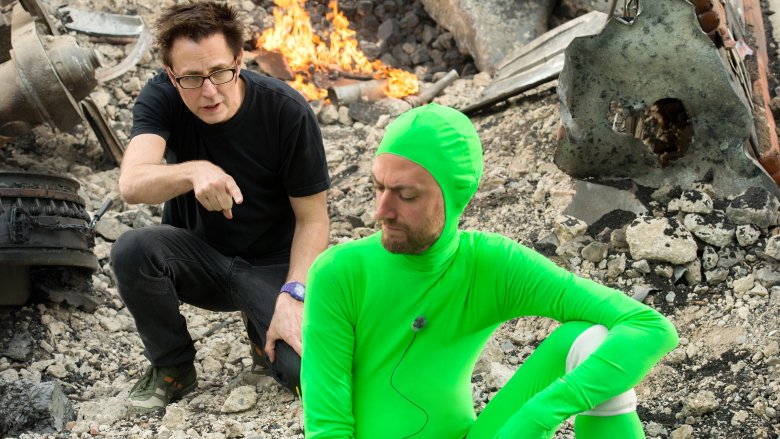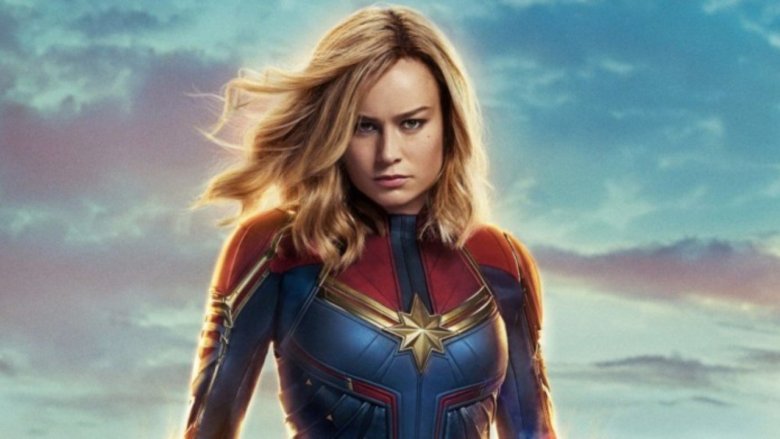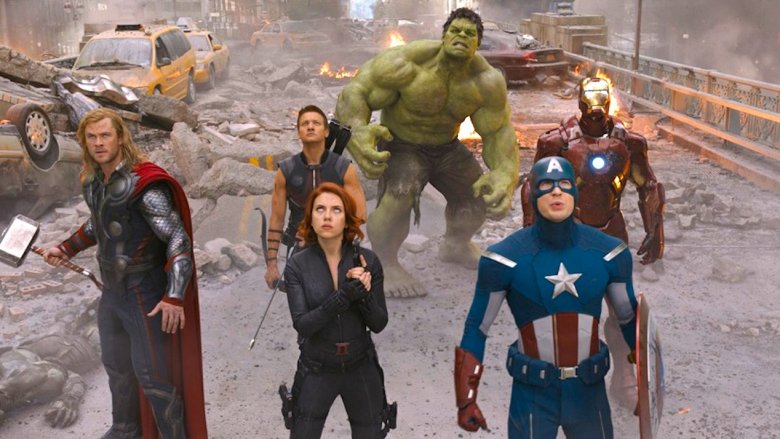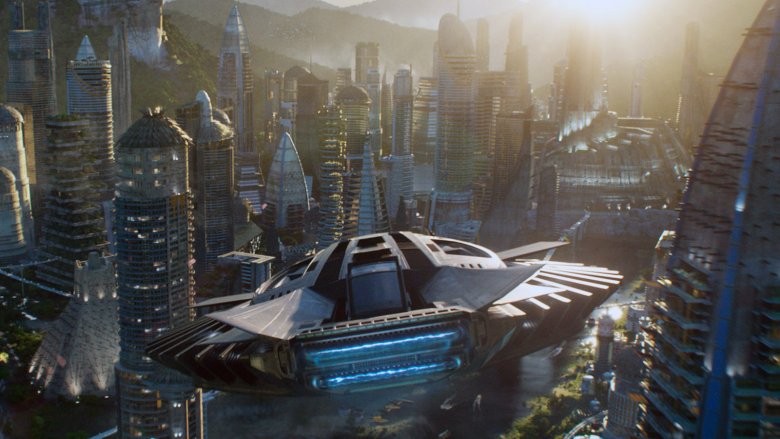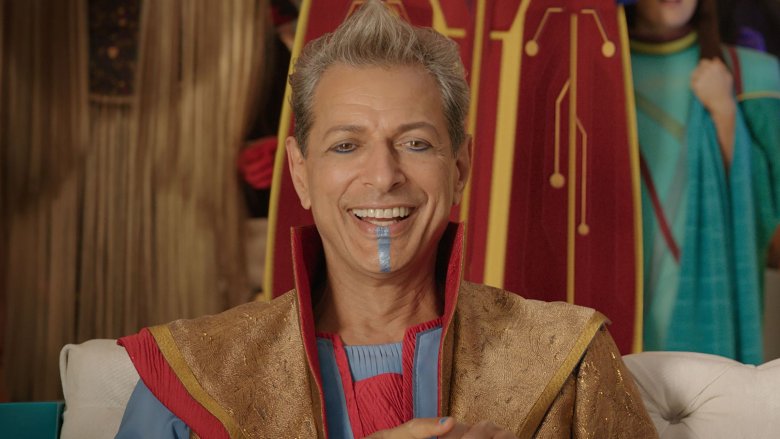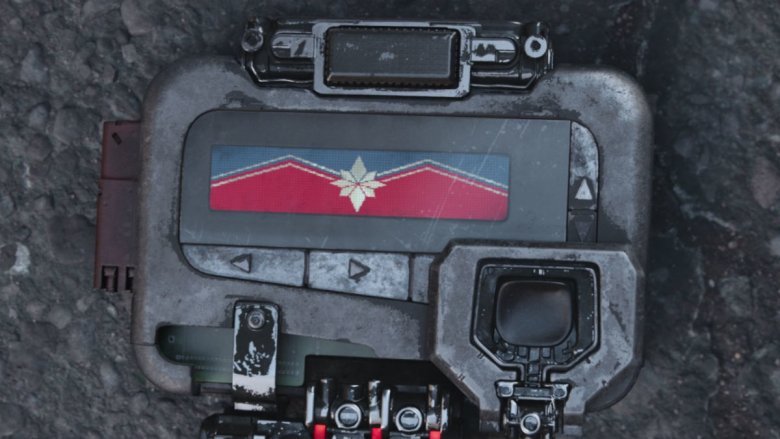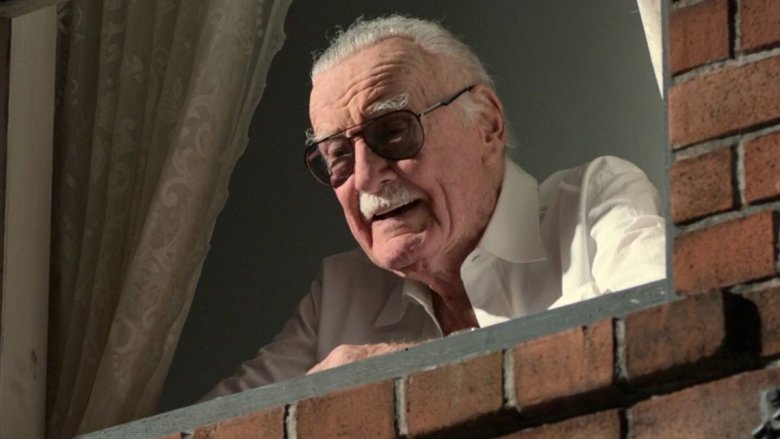Things We See In Every Marvel Movie
Marvel movies have become a cinema staple — you can almost always expect a superhero on at least one screen at your local theater. Ever since the first Iron Man in 2008, the Marvel Cinematic Universe has experienced a kind of big bang — expanding ever outward to include a slew of heroes who had previously only been on the comics pages. From Ant-Man to Yondu, from Happy to Heimdall, there are a ton of characters both good and evil to keep track of. These characters aren't just from Earth, either — they're the endlessly colorful citizens of a wider universe.
Despite this great diversity of characters, settings, and plots, the folks at Marvel make sure that all their narratives are united — each story is a piece in the great puzzle of the MCU, and some key ingredients make Marvel movies distinctive from the average film and allow for these seemingly disparate stories to be assembled together. Not unlike the Avengers themselves, Marvel movies might be different, but have some similarities that allow them to become a blockbuster, record-breaking, award-winning team. With all that in mind, here's a look at the things we see in every Marvel movie.
Comics callbacks
We all know where Marvel movies got their start: stories from the pages of comics that have been beloved for decades. Keeping in mind some of the dated material, stories first penned by Stan Lee and illustrated by Steve Ditko in the Silver Age of comics got some updates in order to better fit the silver screen. The basic spirit of the heroes and villains still remain, however — and comics fans are always delighted to spot scenes in the cinema that are practically reanimated from the source material.
The Infinity War plot as we know it is rooted in the Infinity Gauntlet comic series of the '90s. The films take some significant departures, notably changing Thanos' motivation from a love affair with Death herself to a twisted sense of patrician righteousness, but like all Marvel films, the comics are not forgotten. In the comics, the Silver Surfer crashed meteor-like into Doctor Strange's Sanctum Sanctorum; in the movie, that scene played out with the Hulk. Thanos from the comics and his apparent penchant for turning people into ribbons was also re-rendered onscreen. Nebula being tortured and Vision's violent end were also taken straight from the pages of the Infinity Gauntlet series. The stories of the comics are altered in the retelling, but always leave room for homage and hat tips to the original.
Quotable lines
Marvel films are nothing if not quotable. We have to give the writers some serious props for continuing to create lines that resonate with fans long after the end credits have rolled. Credit goes to Stan Lee, of course, who gave us one of the most famous one-liners in all of Marvel history: "With great power there must also come great responsibility." The 2018 hit Spider-Man: Into the Spider-Verse made a cutoff callback to this line — when Miles tries to quote it at Peter B. Parker, he's yelled at before he can finish. We've heard it plenty of times before.
The first film in the Marvel Cinematic Universe ends with Tony Stark's ultra-memorable admission "I am Iron Man." Stark and his quick, sarcastic wit have given us some of the most quoted Marvel movie quips — like the "genius, billionaire, playboy philanthropist" line lobbed at Captain America, who has some famous phrases of his own, "I can do this all day" included. The more... ridiculous adventures and bombastic personalities of the Guardians of the Galaxy crew have made for some lines fit for T-shirts, too. Who could forget the wise words "I am Groot"?
Humor to lighten the mood
Marvel movies aren't all sunshine and rainbows. Usually, there are dire circumstances that require some super-powered intervention. Our favorite Marvel heroes are always putting their lives on the line, but for the most part, they seem to have fun doing it. Or at the very least, they manage to lighten the mood with a joke or two. Even when the world is about to be decimated, or someone is about to be shot, Marvel characters seem to find a way to make light of the situation with a sarcastic quip. This is what truly separates Marvel from dark and gritty DC, and makes the films palatable for even the most anxious of family members.
Tony Stark manages to give menacing aliens nicknames like "Grimace" and "Squidward" on the fly, and Peter Parker finds delight in being swung at by a super-strong mercenary — "You have a metal arm? That is awesome, dude!" Thor: Ragnarok embraced the tongue-in-cheek approach to apocalyptic circumstances. Thor shed his princely charms entirely and became more of a well-meaning but bumbling jock. Even in Infinity War, when Thanos was near to halving the life in the universe, audiences were cracking up at lines like "Kick names, take ass."
Future character references
The end of 2008's Iron Man establishes some tropes that later become essential to any Marvel movie: the after-credits scene and a nod to another hero. In this case, audiences were surprised by a few more minutes of footage, a shady figure in Tony Stark's mansion who says Stark has become a part of a bigger universe. He's Nick Fury, director of S.H.I.E.L.D, come to talk about the Avengers Initiative.
These days, fans of Marvel movies are primed to find the Easter eggs referencing the thousands of characters that make up the Marvel Universe. Like Fury said, this is a universe, after all, so the movies give a nod toward other heroes if not an outright cameo. The mid-credits scene in Guardians of the Galaxy Vol. 2 featured a wink and a nudge at the future inclusion of Adam Warlock, an as-yet-unseen force capable of apparently destroying the Guardians, created by Ayesha of the Sovereign. Thanos himself was revealed in a similar way during the mid-credits scene of 2012's The Avengers. Though only given a smidgen of screentime, Thanos became hugely important — maybe Adam will too.
The practical effect that we thought was CGI
Marvel films feature a lot of magic, mayhem, and machinery that go beyond the realm of human understanding. In the Marvel Cinematic Universe, Earth isn't the most technologically advanced of planets; in real life, we can't be expected to practically recreate the crazy space battles and firefights that have come to define the action blockbuster. Or can we?
While Marvel movies employ a considerable amount of CGI in order to make movie magic, there are some instances where good old arts and crafts are utilized. Because the films feature characters from various alien races, actors undergo hours of prosthetic and makeup application, resisting the urge to scratch their noses in order to become blue androids and tattooed aliens. Robert Downey Jr. doesn't have to suit up in a real-life (and real heavy) Iron Man suit, however.
Except he does. Sometimes. For Iron Man 3, there was a whole collection of Iron Man suits that Downey and his stuntmen wore, special effects filling in the gaps in the armor. 3D-printed, specially sculpted pieces were put together to form Iron Man suits that would make the best cosplayers envious.
The CGI effect that we thought was practical
We know Mjolnir's lightning strikes are made by very talented people with very high-end computers, but there are other effects that fans might've been surprised to find out were all computer graphics rather than makeup and pyrotechnics. Avengers: Infinity War executive producer Victoria Alonso said that of the film's almost 3,000 shots, 2,900 of them utilize visual effects in one form or another.
Occasionally, even the most skilled makeup artists can't make a young actress appear 50-some years older. In Captain America: The Winter Soldier, VFX were used to age Peggy Carter. The original Captain America placed Chris Evans' face on the body of Leander Deeny, because there was no way Chris Evans could make himself that skinny and short only to later become much taller and muscular. Speaking of body doubles: we know there wasn't a real raccoon waltzing around the Guardians of the Galaxy set, but it may surprise you to learn that director James Gunn's brother Sean managed to waddle at raccoon height as a motion reference for the smart-mouthed little monster.
The supersuit to make merchandise
There's a reason why superheroes don't fight in jeans and T-shirts, and it's to sell T-shirts. Supersuits in Marvel movies are typically near-impervious, aerodynamic, and upgraded with tech suited for tasks like taking on supervillains and stopping disaster. It's only practical that Spider-Man wears a mask and that Captain America carries his shield, but these iconic looks do more than just protect heroes from harm. They sell merchandise.
Every hero comes equipped with their own trademark appearance by the end of the film. In Captain Marvel, Carol Danvers decisively picks a red, blue, and gold aesthetic that is already being made into T-shirts, jackets, hoodies, and hightops. Each character has a color scheme associated with them that later becomes practically synonymous with their name. Symbols, colors, phrases, and likenesses can then be put onto just about anything — buttons, shirts, bags, and much, much more. Disney is making a killing, breaking records in 2013 with $40.9 billion made from licensed merchandise.
Casualties. Lots and lots of casualties.
Even though Marvel movies aren't as some releases from the competition, no one is safe from the inevitability of death in the Marvel Universe. Fighting supervillains and dealing with nuclear warheads will increase the likelihood of death pretty significantly, but usually everyone is able to pull through and survive to see the post-credits scene. Most of the time. Before Infinity War took out half the population, Guardians of the Galaxy had the highest death toll at 83,871, as measured by Digital Spy. Spaceship wars tend to claim a lot of lives, and so do Chitauri invasions of New York City. The first Avengers saw 1,019 casualties.
The people dying aren't often superheroes — they're citizens caught in the crossfire. As an audience, we get teary-eyed saying goodbye to characters like Yondu or Odin, but it's much easier to brush off the hundreds of people carelessly blasted away in grudge matches between superhumans and aliens.
Ultra-futuristic tech... or is it?
The Earth we live in isn't quite as advanced as the Earth featured in the Marvel Cinematic Universe. As much as we'd like to, we haven't yet perfected holograms and AI assistants with the same amount of sass as JARVIS. Even back in the '40s, Steve Rogers was juiced up into a super-soldier. The closest we've got is VR, Siri, and CrossFit.
Although we don't have super-soldier serums, Iron Man suits, or soundless shoes aptly dubbed sneakers by Shuri, the futuristic tech featured in the Marvel Universe is based in reality. Wakandan tech isn't nearly as far away as we think it is. In Black Panther, vibranium is transported via magnetically levitating trains. This tech has been around for decades — the world's fastest train, in Japan, is powered by maglev technology. Wakanda is hidden from the world via cloaking, and while we can't make whole cities invisible, the U.S. military is able to make massive ships seem much smaller on radar and other tracking devices. Energy-absorbing supersuits and spaceships outfitted with lasers are probably a little ways off, however.
Classic supporting characters
The one thing all Marvel movies get right is serving up good characters. The studio has a wealth of well-established names to pull from, and sometimes moviegoers are already big fans of heroes who've yet to make their big screen debut. We were charmed by Tony Stark. We love Star-Lord. We cheered on Thor and couldn't wait to meet Captain Marvel. Title characters are great, but we'll be real: sometimes supporting characters steal the show.
Tony Stark wouldn't have been quite as funny without JARVIS to sigh at his decisions, and it's kind of impossible to pay attention to anyone else onscreen when there's a talking raccoon with a gun fetish trying to steal prosthetic legs. Thor: Ragnarok wasn't just great because of Thor — it also had Jeff Goldblum playing the megalomaniac Grandmaster and director Taika Watiti adding the distinctively Kiwi voice of Korg. Even Captain Marvel isn't safe from audiences being distracted by side characters. As difficult as it is to look away from Brie Larson, we all loved the cat-shaped alien Goose. Marvel has great heroes and even better secondary characters. Goose deserves his own movie.
After the credits
It's become a tradition when a Marvel film comes to a close and the credits start to roll for moviegoers to turn to each other and ask, "Is there a post-credits scene?" Usually, the answer is yes. This tradition started with Iron Man and Nick Fury surprising audiences with the announcement of the Avengers Initiative. Now, Marvel movies always keep their audiences hostage while the credits play with the promise of one more scene waiting for them at the end.
Sometimes they're just fun, bonus scenes like a teenage Groot playing video games and being angsty. Other times this extra material actually offers critical information as to where the plot is leading. At the end of Infinity War, everything looked pretty bleak. An end-credits scene painted an even darker picture with Nick Fury fading into dust. Before that, he managed to hit the button on a modified pager, bringing up a symbol that was a cause for hope: he'd messaged Captain Marvel. These post-credit scenes, whether funny or plot-heavy or both, have trained Marvel fans to be patient. And to not chug their drink, lest they have to hoof it to the restroom and miss the 30 seconds of bonus Marvel goodness.
Stan Lee
Stan Lee helped create a whole universe of stories and characters that are now beloved by generations. In his work, he championed the underdog and the outcast, something Hollywood apparently considered him to be at one point. Although Stan had appeared in minor roles in the 1989 TV movie The Trial of the Incredible Hulk and 2000's X-Men, director Sam Raimi wasn't sold on Stan appearing in 2002's Spider-Man, saying that he couldn't act.
It's hard to understand where he got that idea. In a series of MCU cameo appearances that fans quickly came to expect, he went from being an extra in the background to having lines and often stealing the show. He was a bus driver, a mailman, a security guard, and something of a ladies' man, always with a funny quip at the ready. He's said some pretty profound things onscreen.
Stan Lee passed away in 2018 at the age of 95, but reportedly filmed multiple cameos for multiple upcoming Marvel features prior to his passing. We'll miss you, Stan. Excelsior.
